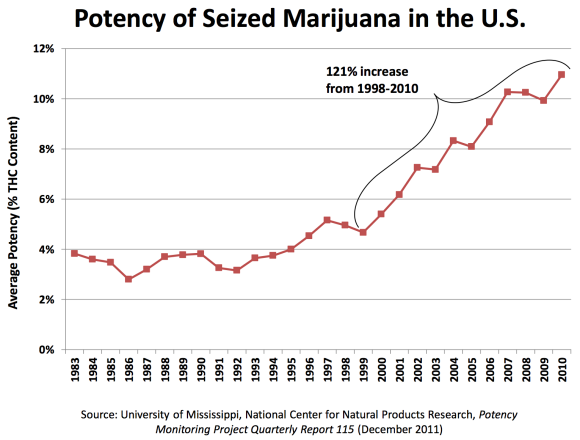Smurfing: how the US war on drugs makes criminals of tourists
THE USA’s attitude to marijuana is mixed. Brannon P. Denning, Samford University – Cumberland School of Law, considers the problem of one American’s rights being another man’s crime in a paper called: One Toke Over the (State) Line: Constitutional Restrictions on State ‘Pot Tourism’ Restrictions:
Among the myriad legal issues confronting states like Colorado that are experimenting with the legalization of marijuana is the need to regulate “pot tourism” by persons from other states where marijuana is not legal. In Colorado, the final recommendations from the Amendment 64 Implementation Task Force included a proposal, “to limit purchases by state residents to an ounce at a time and to a quarter of an ounce for out-of-state visitors.” The lower restrictions for nonresidents are designed to deter pot tourists from “smurfing” — visiting a number of different dispensaries to accumulate larger amounts of marijuana with a view to illegally reselling the pot. Colorado’s legislature adopted the Task Force’s recommendation in House Bill 1317, recently signed into law by Colorado’s governor, which established the regulatory framework for the legal sale of marijuana. Among its provisions is a quarter-ounce purchase limit for nonresidents.
Smurfing? Why not just legalise it everywhere to stop the crime?
Treating purchasers of a legal product differently based on state residency implicates constitutional doctrines that limit a state’s ability to discriminate against nonresidents. This essay examines the Colorado recommendation in light of two of those doctrines: the Privileges and Immunities Clause of Article IV, Section 2; and the Dormant Commerce Clause Doctrine (DCCD). At first glance, Colorado’s facially discriminatory law appears to be almost certainly unconstitutional under current doctrine.
Weed use has been destigmatized, but it remins illegal and its use, especially in young teenagers, is not without dangers to health.
Sean Trende looks at how attitudes to marijuana have changed and why:
Remember, when marijuana was first introduced into American society, it was considered a lower-class drug, brought over by Mexican laborers and supposedly indulged in by African-Americans. It was treated as a street drug; one law enforcement officer writing to [Herbert] Hoover in 1929 described it as more damaging than opium or cocaine, and influenced cultural depictions in films like “Reefer Madness,” “Marijuana: Weed With Roots in Hell,” and “Assassin of Youth.” This was the attitude that the “silent generation” and the “greatest generation” held throughout their lives and it is part of why, in Gallup’s 1979 polling, 72 percent of 30- to 49-year-olds and 84 percent of those 50 and older opposed legalization.
But 18- to 29-year-olds were much more favorably inclined toward legalization. The change comes following marijuana’s journey into the counterculture in the ’60s, and those individuals’ subsequent journey to become doctors and lawyers. This shows up, too, in the following tidbit from the report: 30- to 64-year-olds were about as likely to have used marijuana as 18- to 29-year-olds (50 percent vs. 56 percent), vs. only 22 percent of those over the age of 65.
At the same time, cultural depictions of marijuana use have changed. It’s no longer counterculture hippies and African-Americans (remember who smokes up in “Back to the Future”?) who smoke marijuana. It’s Nancy Botwin, the plucky housewife from “Weeds,” supplying the suburban wasteland. And interestingly, the arguments that really move public opinion here are those that are almost conservative in nature: legalization saves money; legalization can forestall the need for property or income taxes (on middle Americans, implicitly); legalization frees up police resources for violent criminals.
What people want marijuana for is not always to get high:
Under Washington State law, marijuana is defined as cannabis with a THC concentration greater than 0.3 percent. Anything with less THC is not marijuana under state law; it is simply unregulated cannabis. Thanks to Initiative 502, we no longer prohibit this unregulated cannabis, which includes such commodities as industrial hemp, edible pot sprouts, and seeds.
But THC, the molecule primarily responsible for the psychoactive effects of pot, is just one of at least 85 known cannabinoids in the plant, and it turns out some people aren’t looking for THC. Many dispensaries report that patients often want pot that is high in other medicinal compounds—like cannabidiol (CBD), which is thought to have a greater effect on pain.
One such strain found locally is called M’Otto, and with 0.23 percent THC and nearly 11 percent CBD, it is not technically marijuana under state law. It certainly looks like marijuana, smells like marijuana, and smokes like marijuana. But around here, it is only unregulated cannabis. ”Since we’ve had it in for about a year, I would say it’s the fifth or sixth fastest-moving strain we carry,” says Muraco Kyashna-tocha from the Green Buddha Patient Co-op.
Isn’t there an argument that says legalisation means the user isn’t exposed to the really strong stains of weed? The cannabis tourist might be just looking for a drug they can control…
Posted: 11th, June 2013 | In: Reviews 0 Comments | TrackBack | Permalink



